Japan
Wood Products Prices
Dollar Exchange Rates of 25th
May
2021
Japan Yen 108.76
Reports From Japan
¡¡
Private consumption takes
a battering
The Japanese government has lowered its assessment of
prospects for the economy. This is the first downgrade in
three months and comes as private consumption has taken
a battering due to the extension of the state of emergency.
According to the Cabinet Office the economy shows
¡°further¡± weakness in some areas and is in a severe
situation. In the previous monthly report the government
said the economy showed weakness in some components
but did not use the word ¡°further¡±.The report covering
April says,for the first time in four months, businesses
¡°appear to be pausing¡± their recovery while ¡°some severe
aspects still remain¡±.
The current restrictions under the state of emergency were
due to be lifted 11 May but were extended to the end of
May after pleas by the worst affected prefectures. Because
of the continued high rate of infections the government has
decided to extend the state of emergency in 9 prefectures
to 20 June.
See:
https://www.japantimes.co.jp/news/2021/05/26/business/economy-business/japan-economic-assessment
Firm overseas demand lifts machinery orders
The Cabinet Office says March machinery orders rose
almost 4% compared to February, the first increase in
three months. This is in contrast to the almost 9% decline
in fiscal 2020.
Private-sector machinery orders, excluding those for ships
and power companies, increased a seasonally adjusted by
3.7% in March but for the quarter were down around 5%.
The Cabinet Office has forecast private sector machinery
orders in the second quarter will rise by 2.5% from first
quarter. Supporting the forecast is sentiment among
manufacturers which was at a two-year high in May on
the back of firm overseas demand.
See:
https://www.esri.cao.go.jp/en/stat/juchu/2021/2103juchue.html
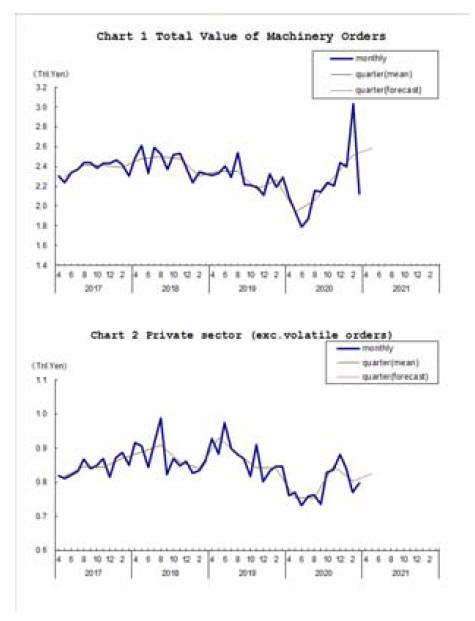
First quarter dip in GDP
Data from the Cabinet Office shows that Japan's economy
contracted in the first quarter of this year, dropping by an
annualised 5.1% from the previous quarter. However, the
result was not as bad as the record drop of around 29% in
the April-June quarter last year.
The second state of emergency declared in early January
to try a stem the rate of spread of infections drove down
consumer spending which accounts for more than half of
GDP. In contrast, exports expanded over 2% in the first
quarter 2021 building on the increases for the past three
quarters. The government is forecasting GDP will grow by
4% percent in real terms in the current fiscal year that ends
March 2022.
The risk is that if infections continue to spread a
nationwide state of emergency may be declared but the
government approach at the moment is to enforce effective
measures regionally but prefectural governors have
requested stronger measures before it¡¯s too late.
On 21 May the government extended the state of
emergency to Okinawa as infections in the island
prefecture continue. The inclusion of Okinawa brings the
number of prefectures under the state of emergency to 10.
The aim was to lift the state of emergency on 31 May but
calls have grown for tougher restrictions in Tokyo and
other areas and for the state of emergency to be extended
beyond 31 May.
Responding to the dip in GDP the Governor of the Bank of
Japan (BoJ) warned that, because of uncertainty over the
pace of the country's vaccination rollout, the domestic
economy remains in a "severe" state and economic
activities are at levels lower than before the pandemic.
The BoJ indicated it will consider extending support for
corporate funding beyond the end of September if the
situation demands this.
The BoJ¡¯s view is that the impact of COVID-19 could
subside by mid 2022 if the vaccination effort is ramped up
but that risks are skewed to the downside given
uncertainties on how the differing paces of vaccinations in
countries and regions will impact the global economy.
See:
https://www.japantimes.co.jp/news/2021/05/17/national/japannationwide-state-of-emergency-pressure/
and
https://mainichi.jp/english/articles/20210519/p2g/00m/0bu/083000c
The May consumer confidence indices remain largely the
same as in April.

Yen movement hinges on US interest rates
The yen, along with many other major Asia-Pacific
currencies, dipped lower against the dollar briefly midmonth
as a rise in US consumer inflation pushed the US
dollar higher. However, the change was short lived as
Federal Reserve played down the impact of higher
inflation on monetary policy. The yen/dollar exchange rate
at the end of May was little changed from a month earlier.
In April US consumer prices jumped more than seen over
the past decade as demand surged after the economy was
freed of most restrictions on businesses.
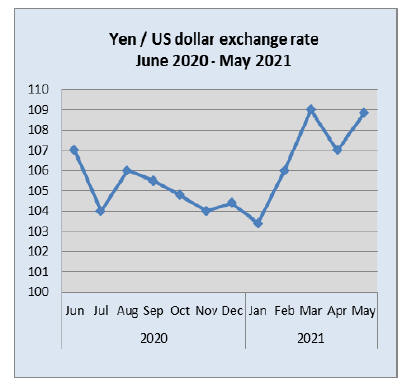
Demolish and rebuild ¨C homes in Japan
A large number of housing starts in Japan are
replacements of existing buildings that are considered to
have reached the end of their service life. The Japanese
government dictates the ¡°useful life¡± of a wooden house
(by far the most common) to be 22 years so it depreciates
them over that period according to a schedule set by the
National Tax Agency.
This unique concept in the housing market creates a great
deal of problems for home buyers. Even if a buyer wanted
to buy an existing (old, 22 years) house they would have
to pay cash as banks will not lend against what is
considered a worthless asset.
Construction activity accounts for 6% of GDP in Japan but
the sector is a huge employer and construction supports
many small suppliers and in Japan the housing legislation
is based on the principle of demolition of existing homes
and replacement.
See:
https://robbreport.com/shelter/home-design/japanesehomes-are-ephemeral-facing-demolition-just-22-years-in-hereswhy-1234608438
April 2021 housing starts were up 8% on April 2020 but
down 5% in pre-pandimic 2019.
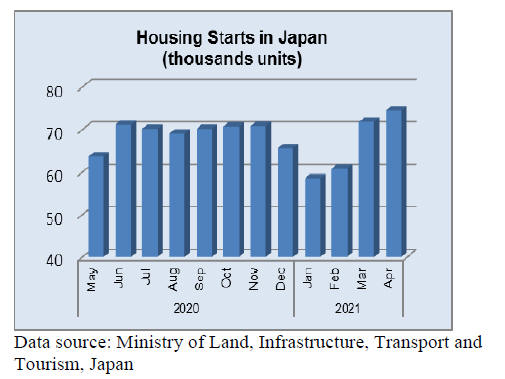
Import update
Furniture imports
The value of Japan¡¯s wooden furniture imports
(HS940303/40/50) in the first quarter 2021 have risen to
and in the case of bedroom furniture exceeded, the value
of pre-pandemic 2019 imports.
The value of wooden office furniture (HS940330) imports
in the first quarter of 2021 was up 46% on the same period
in 2020 and 6% higher than in the first quarter 2019.
The value of wooden kithen furniture (HS940340) imports
in the first quarter of 2021 were up 10% on the same
period in 2020 and were at the same level as in the first
quarter 2019.
The value of wooden bedroom furniture (HS940350)
imports in the first quarter of 2021 were up 20% on the
same period in 2020 and were up 21% on the first quarter
2019.

Office furniture imports (HS 940330)
Year on year the value of Japan¡¯s imports of wooden
office furniture (HS940330) in March 2021 jumped a
massive 95% and month on month the value of March
imports was 70% higher than in February. For most
shippers March shipments were higher than in February
except those in China.
¡¡
The import data from the Japanese Ministry of
Finance
shows a very large value of wooden office furniture
arrived from France in March and this accounted for
almost 30% of all March wooden office furniture imports.
Manufacturers in Vietnam had consistently held the
number two spot in terms of value of shipments to Japan
but with the surge in imports from France Vietnam
became the third ranked supplier in March.
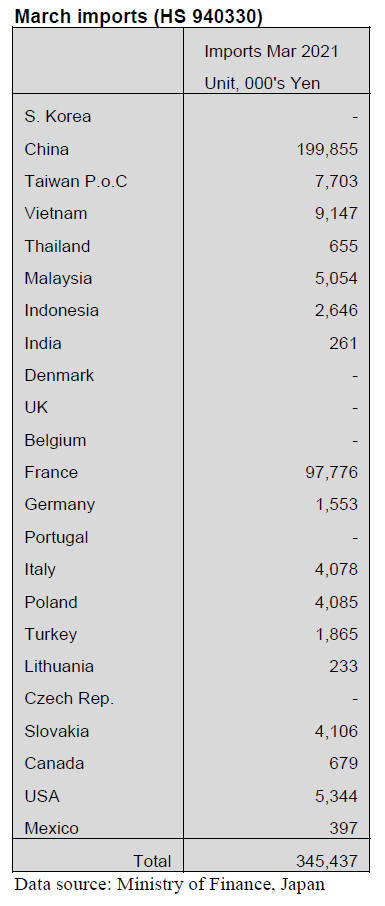
Kitchen furniture imports (HS 940340)
The recovery of Japan¡¯s wooden furniture imports
continued with wooden kitchen furniture. The value of
March imports rose 22% year on year in March 2021 and
was up 16% from levels in Febuary 2021.
Shipments from just three countries, the Philippines,
Vietnam and China accounted for over 85% of all wooden
kitchen furniture imports in March. The Philippines
topped the list accounting for 43% of March arrivals
followed by Vietnam (36%) and China. However arrivals
from China in March were sharply down compared to a
month earlier.

Bedroom furniture imports (HS 940350)
After starting 2021 on a high note, the value of Japan¡¯s
imports of wooden bedroom furniture dropped in February
and the downtrend continued into March when the value
of imports fell a further 13% compared to a month earlier.
A correction is not surprising given the big jump in first
quarter imports.
Between them, shippers in China and Vietnam accounted
for most (87%) of the value of March arrivals into Japan.
The other significant shpoper in March was Malaysia
which saw a 6% increase in March shipments over
February.
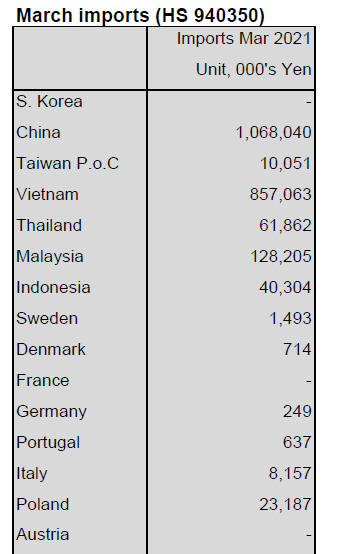 
Trade news from the Japan Lumber Reports (JLR)
The Japan Lumber Reports (JLR), a subscription trade
journal published every two weeks in English, is
generously allowing the ITTO Tropical Timber Market
Report to reproduce news on the Japanese market
precisely as it appears in the JLR.
For the JLR report please see:
https://jfpj.jp/japan_lumber_reports/
Forestry Agency held meeting to discuss wood
shortage
The Forestry Agency held emergency meeting to exchange
information to deal with shortage of wood products.
Recent incident of sharp drop of imported wood products
from North America and Europe with inflating prices and
resultant demand increase to domestic wood is the main
subject.
Associations of precutting business and contractors
participated the meeting and loudly complain about
shortage of necessary wood products and they may be
forced to reduce production or decline taking orders if this
situation continues. Precutting plants in Tokyo and Osaka
regions, which rely on supply of imported materials, are
struggling to secure necessary materials and are forced to
reduce the operations.
Some plants use its own supply of domestic wood but
supply of domestic wood is also getting tight so there are
some comments that growing log export business should
be restricted temporarily until the supply eases.
The Japan Lumber Importers Association reports that
booming housing starts in the U.S.A., which is main
reason of supply tightness of North American lumber may
last all through this year and it is not certain that supply
tightness is temporary or long lasting.
Domestic wood cannot replace structural materials in
terms of strength but tight supply from North America
would last longer.
The National Federation of Forest Owners Cooperative
Association attended to represent domestic log producers
and log suppliers are not sure if this demand increase is
real since plywood mills reduced log purchase last fall
because of production curtailment program. They are
worried about price drop by oversupply of logs so log
production is being held down partially by this reason.
If domestic logs are used to substitute imported logs,
manufacturing of logs should be changed such as length
and diameter sorting.
The Japan Federation of Plywood Manufacturers
Association and the Japan Laminated Lumber
Manufacturers Association participated the meeting and
reported that the production has been increasing since last
March but the production is not enough to satisfy the
demand and the prices would continue to climb.
Changing construction materials
By supply shortage of Douglas fir and hemlock lumber
from North America, substituting materials are being used.
In Gunma and Ibaraki prefecture, north of Tokyo, Douglas
fir girder and hemlock purlin have been used for years but
now the supply gets real tight and precutting plants need to
look for something else.
In Gunma, local contractors like to use Douglas fir KD
rafter but the supply disrupted since late February so they
consider to use whitewood, cypress and hemlock but
settled with KD cedar by reason of supply stability. KD
Douglas fir rafter is short in supply then the prices soared
to almost 80,000 yen per cbm delivered so price difference
widened to 20-30,000 yen from KD cedar.
Supply of European structural laminated lumber decreased
by 20 -30% and search for substituting materials is
overheated. The market became chaotic by delayed
container arrivals of lamina and finished lumber. Redwood
laminated post became short first then whitewood
laminated post supply gets tight in early April so
precutting plants frantically look for laminated cedar post,
KD cedar and cypress post. KD cedar post prices are now
70-80,000 yen per cbm.
KD cedar post prices had been around 55,000 yen per cbm
delivered up until last March then in April, they jumped up
to 65,000-70,000 yen and May prices may go up by 5,000-
10,000 yen. Cedar laminated post prices were 52-55,000
yen in April.
Struggling precutting plants
Precutting plants face critical shortage of necessary
building materials so many will have to reduce processing
volume considerably in May.
In Tokyo region, laminated lumber manufacturing plants
experience lamina shortage since late March so operation
of precutting plants dropped. Operational rate now
depends on how much materials are available. In
particular, beam supply is way down so some plants run
only 70-80% of the capacity.
Supply of laminate post and beam is short. Solid wood
Douglas fir beam is allocated by past purchase volume.
Redwood laminated beam is very tight. Some precutting
plant says that since late March, beam supply stopped and
40 units are short with beam so May processing may drop
down to 50% of normal pace.
Precutting plants, which mainly use domestic wood, rely
on imported redwood laminated lumber for beam. Also
whitewood laminated post supply started declining since
April so precutting plants look for substituting materials
but laminated cedar lumber supply is not enough to satisfy
shortage of imported products. KD cedar lumber is also
very tight in supply. Demand goes to KD cypress but this
is also short.
After all, precutting plants are so desperate that they can
take any 105 mm square regardless of species now.
In auction market, dealers are buying with high prices to
secure the volume.
On Russian red pine KD taruki (30x40 mm/ 4 meter),
there was no worry about supply shortage since the
inventory has variety of grades but the Russian supply is
shrinking by logs and container shortage. In auction
market, quality red pine taruki prices are now over 80,000
yen per cbm, more than 10,000 yen higher than last
February. There is no substituting material. Supply volume
of poplar LVL is limited.
Red pine taruki can be used not only for newly built
houses and renovation but also for events and stage so
dealers want to keep it in inventory. There is no KD
whitewood stud available now.
The prices were down to 40,000 yen plus in summer of
2020 by over supply but now the prices are over 60,000
yen. To replace this, domestic cedar stud draws more
attention and the prices are 65,000-70,000 yen, 5,000 yen
higher than April. Domestic softwood LVL (45 mm
square/3, 4 meter) can be used as brace, joist and stud so
some dealers are eyeing this item.
Domestic logs and lumber
Demand of domestic logs and lumber has been sharply
increasing when the supply of imported products is steeply
down. Sawmills have started full production since last
March but the demand is far larger than supply.
Supply shortage results in higher prices of lumber.
Particularly Tokyo market, where the demand is larger
than the other regions, extreme high prices are seen in
purchase competition. Log prices are also climbing steeply
with busy demand by sawmills.
Substituting demand of domestic logs and lumber
suddenly spurted since last March and there is no sign of
easing yet. 3 meter cedar 105 mm post prices were 52,000-
53,000 yen until March then they rose to 55,000-60,000
yen in many areas but in Tokyo region the prices soared
70,000-75,000 yen with high spot prices of 80,000-90,000
yen.
Log production is stable. 3 meter post cutting cedar log
prices are 12,000 yen in average but in Tokyo and Kyushu
region where large sawmills are up to 16,000-19,000 yen.
4 meter sill cutting cypress log prices range from 20,000 to
26,000 yen.
Plywood
Pressure for price increase is getting stronger on both
domestic and imported plywood. Users of domestic
softwood plywood are trying to procure necessary volume
as soon as possible in fear of supply tightness after all
kinds of imported building materials are extremely tight.
Also the users fear that the prices of softwood plywood
would go up again as prices of material cedar logs are
climbing by active demand for lumber. One concern is if
precutting plants¡¯ operations are forced to be down by
materials shortage, overall consumption of softwood
plywood would be down but so far, orders are busy to
secure immediate needs.
Softwood plywood manufacturers are considering to raise
the sales prices again since cedar log prices continue
climbing.
In imported plywood, supply shortage of standard
plywood is grave. In particular, plywood used as floor
base is very short and floor manufacturers are increasing
the sales prices. Some consider to change to other
materials like MDF but the prices are also high. Concrete
forming 12 mm panel demand is weak. So far, there is no
influence to construction works.
Domestic logs and lumber export
Cedar log export to China stagnated in the first half of
2020 because of COVID 19 pandemic and the export
prices dropped down to $ 115 per cbm C&F but recovery
of China market was much quicker than expected and log
demand sharply increased in the second half and C&F
prices shot up to $140 by the end of 2020.
According to the trade statistics by the Ministry of
Finance, log export in 2020 was about 1,380 M cbms,
22.5% more than 2019 and the value was 16,341 million
yen, 11.1 more than 2019.
Demand in China continues active in 2021 and March
export prices are $165 per cbm C&F but freight increased
so that revenue to log exporters is not as high as nominal
prices.
At the same time, domestic prices of cedar logs have been
climbing as the demand is increasing to substitute tight
supplied imported products from North America and
Europe since second half of 2020. 8 cm up cedar log
prices were about 7,500 yen per cbm delivered loading
ports in fall of 2020 but they rose to 10,000 yen by
December.
Besides China, cedar fence lumber demand in the U.S.A.
continues active and cedar log demand inn Korea and
Taiwan is also increasing.
Export of domestic lumber continues expanding. It was
13,726 cbms in February 2021, 25.9% more than February
2020. The value is 579.59 million yen, 31.7% more.
Export volume peaked in the fourth quarter 2020 and it
declined by about 30% because of active domestic demand
and shortage of containers. Sawmills give priority to
domestic orders.
Destination of lumber is the U.S.A. with fence lumber,
Philippines with structural lumber for housing, China with
interior finishing of condos and furniture manufacturing.
Total export in 2020 is 169,768 cbms, 18.7% more than
2019 and the value is 6,278 million yen, 115.8% more. In
particular, lumber export to the U.S.A. is 52,485 cbms,
115.8% more. Volume for China is 63,683 cbms, 2.0%
more. Ocean freight to the U.S.A. increased by double or
three times so sawmills¡¯ revenue is squeezed.
Demand for cedar taruki and small lumber is increasing
after the supply from foreign sources decreases and the
prices are up by 3,000-5,000 yen. With this increase,
lumber export business is not as attractive as before.
Hyuga biomass power generation project
Four companies jointly invest to construct biomass power
generation plant in Hyuga, Miyazaki prefecture.
Itochu Corporation (Tokyo) invests 35%, Osaka Gas Co.,
Ltd. 35%, Tokyo Century 25% and Tokyo Energy and
system Inc. 5% to establish Hyuga Wood Biomass Power.
Annual fuel consumption would be more than 200,000
ton. Both domestic and imported materials are used.
Majority would be imported wood pellet. Itochu is in
charge of supplying imported fuel and Green Power Fuel
(GPF) of Osaka Gas group will supply domestic wood
pellet.
Start-up is scheduled in November 2024. Power output is
50,000 kw.
Itochu and Osaka Gas with Mitsui E&S Engineering
invested jointly invested and started up operation of
Ichihara Biomass Power plant in December 2020 at
Ichihara, Chiba prefecture. Power output is 49,900 kw.
|